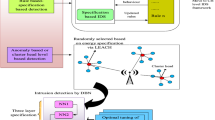Abstract
Design of intrusion detection, and MANET prevention mechanism, with scrutinized detection rate, memory consumption with minimal overhead are crucial research concerns. Node mobility and energy of the node are dual essential optimization issues in mobile ad hoc networks (MANETs) where nodes traverse uncertainly in any direction, evolving in topology's continuing modification. A Centrality Epilson Greedy Swarm and Gradient Deep Belief Classifier (CEGS-GDBC) for multi-attack intrusion detection are designed with the proposed method. The paper concentrates on the issues of node mobility and energy to emerge a clustering algorithm inspired by Dual Network Centrality for cluster head election in MANET. Compact cluster formation is done with the help of Epilson Greedy Swarm Optimization. Finally, with a hybrid type of IDS, Gradient using the Deep Belief Network Classifier identifies multi-attack, i.e., DoS and Zero-Day attack. The proposed work is experimented extensively in the NS-2 network simulator and compared with the other existing algorithms. The proposed method's performance is studied in terms of different parameters such as attack detection rate, memory consumption, and computational time for identifying and isolating the intruder. Simulation results show that the proposed method extensively minimizes the IDS traffic and overall memory consumption and maintains a high attack detection rate with minimal computational time. From the results, CEGS-GDBC method increases the attack detection rate by 31% and reduces the memory consumption and computational time by 39% and 41% as compared to Fuzzy elephant—Herd optimization and Cross centric intrusion detection system.










Similar content being viewed by others
References
Abdollahi A, Fathi M (2020) An intrusion detection system on ping of death attacks in iot networks. Wirel Pers Commun 112:2057–2070
Akhtar N, Khan MA, Ullah A, Javed MY (2019) Congestion avoidance for smart devices by caching information in manets and IoT. IEEE Access 7:71459–71471
Al-Jarrah OY, Maple C, Dianati M, Oxtoby D, Mouzakitis A (2019) Intrusion detection systems for intra-vehicle networks: a review. IEEE Access 7:21266–21289
Aloqaily M, Otoum S, Al Ridhawi I, Jararweh Y (2019) An intrusion detection system for connected vehicles in smart cities. Ad Hoc Netw 90:101842
Cherkaoui B, Beni-hssane A, Erritali M (2020) Variable control chart for detecting black hole attack in vehicular ad-hoc networks. J Ambient Intell Humaniz Comput 11(11):5129–5138
Doss S, Nayyar A, Suseendran G, Tanwar S, Khanna A, Thong PH et al (2018) Apdjfad: accurate prevention and detection of jelly fish attack in MANET. IEEE Access 6:56954–56965
Gaurav A, Singh AK (2020) Light weight approach for secure backbone construction for manets. J King Saud Univ Comput Inf Sci 13(4):1292–1302
Gomathy V, Padhy N, Samanta D, Sivaram M, Jain V, Amiri IS (2020) Malicious node detection using heterogeneous cluster based secure routing protocol (HCBS) in wireless adhoc sensor networks. J Ambient Intell Humaniz Comput 11(11):4995–500
Kavitha T, Geetha K, Muthaiah R (2019) India: Intruder node detection and isolation action in mobile ad hoc networks using feature optimization and classification approach. J Med Syst 43(6):179
Mafra PM, Fraga J, Santin AO (2014) Algorithms for a distributed ids in manets. J Comput Syst Sci 80(3):554–570
Marchang N, Datta R, Das SK (2016) A novel approach for efficient usage of intrusion detection system in mobile ad hoc networks. IEEE Trans Veh Technol 66(2):1684–1695
Nishani L, Biba M (2016) Machine learning for intrusion detection in manet: a stateof- the-art survey. J Intell Inf Syst 46(2):391–407
Otoum Y, Liu D, Nayak A (2019) DL‐IDS: a deep learning–based intrusion detection framework for securing IoT. Trans Emerg Telecommun Technol e3803
Patil S, Borade D (2014) Dynamic cluster based intrusion detection architecture to detect routing protocol attacks in manet. Sens Netw Data Commun 3(116):2
Poongodi M, Bose S (2015) A novel intrusion detection system based on trust evaluation to defend against ddos attack in manet. Arab J Sci Eng 40(12):3583–3594
Rajendran N, Jawahar P, Priyadarshini R (2019) Cross centric intrusion detection system for secure routing over black hole attacks in manets. Comput Commun 148:129–135
Sivanesh S, Dhulipala VS (2020) Accurate and cognitive intrusion detection system (acids): a novel black hole detection mechanism in mobile ad hoc networks. Mob Netw Appl 1–9
Thanuja R, Umamakeswari A (2018) Unethical network attack detection and prevention using fuzzy based decision system in mobile ad-hoc networks. J Electr Eng Technol 13(5):2086–2098
Thanuja R, Umamakeswari A (2019) Black hole detection using evolutionary algorithm for ids/ips in manets. Clust Comput 22(2):3131–3143
Veeraiah N, Krishna B (2020) An approach for optimal-secure multi-path routing and intrusion detection in manet. Evol Intell 1–15
Velliangiri S, Pandey HM (2020) Fuzzy-taylor-elephant herd optimization inspired deep belief network for ddos attack detection and comparison with state-of-the-arts algorithms. Future Gener Comput Syst 110:80–90
Author information
Authors and Affiliations
Corresponding author
Additional information
Publisher's Note
Springer Nature remains neutral with regard to jurisdictional claims in published maps and institutional affiliations.
Rights and permissions
About this article
Cite this article
Dilipkumar, S., Durairaj, M. Epilson Swarm Optimized Cluster Gradient and deep belief classifier for multi-attack intrusion detection in MANET. J Ambient Intell Human Comput 14, 1445–1460 (2023). https://doi.org/10.1007/s12652-021-03169-x
Received:
Accepted:
Published:
Issue Date:
DOI: https://doi.org/10.1007/s12652-021-03169-x




